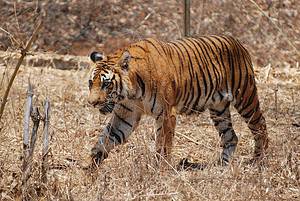Despite being large and brightly colored, tigers are very stealthy, deadly animals. They have no problem bringing down deer and cattle, and they can be a serious threat to humans. The Champawat Tiger was a female Bengal tiger that lived in the late 19th century and early 20th century. This was the deadliest man-eating tiger of all time, killing several hundred people over four years in Nepal and India.
Let’s take a closer look at this tiger, the turmoil it caused, and how these deadly attacks were finally brought to an end.
About the Man-Eating Tiger

Bengal tigers are large felines that can weigh up to 600lbs.
©Mary Angela Heys/Shutterstock.com
The Champawat Tiger was a Bengal Tiger. These big cats can weigh between 300 and 600lbs, measure from 6.8-11ft long, and stand a few feet high at the shoulder. Female tigers are more likely to be toward the smaller end of those measurements. Like most other tigers, their fur is black, white, and orange. They tend to be solitary creatures.
Tigers’ canines can measure up to 3.5 inches long, and they can bite with force exceeding 1,000 PSI. Their bodies are heavy and muscular, and they can easily pin prey before dispatching them with their teeth and claws.
Today, Bengal tigers are not as numerous as they were in the past. Still, their native range includes India, Bhutan, Bangladesh, and Nepal, and they can travel long distances each day. Bengal tigers can run at speeds of up to 40 miles per hour, making them incredibly swift predators that can take people and other animals by surprise.
The thing that makes tigers even more dangerous to people is their ability to ambush their prey from stealth. These tigers can attack under cover of darkness and during the day, cause fatal damage with an ambush, and disappear into the thick forests and overgrowth from which they came.
With such an incredible mixture of size, speed, and power, the Champawat tiger easily killed humans.
Before the Mid-20th Century, Tigers Reigned Over the Indian Subcontinent

The Bengal tiger is the most well-known tiger.
©dangdumrong/Shutterstock.com
Before we get further into the case of the Champawat Tiger, it’s important to realize that she was not the only tiger killing people in India and the surrounding counties.
Over 1,000 people in the Indian subcontinent died each year due to tiger attacks throughout the latter part of the 19th century. For five years in the mid-1930s, tigers killed over 7,000 people throughout India. Despite a dwindling population, tigers continue to kill people to this day, with up to 100 people dying per year.
Before the mid-20th century, tigers killed many human beings, and it was very difficult to reduce the threat they posed to humans. Unfortunately, tigers were ruthlessly hunted until they became critically endangered. Questions of how to co-exist with tigers are still raised and discussed in the present.
Where Did the Man-Eating Tiger Attack?

The Champawat Tiger hunted in Nepal and India.
©iStock.com/BreakingTheWalls
The Champawat man-eating tiger killed many people throughout its active years. The tiger began attacking and killing people in Nepal during the early years of the 20th century. During this time, it was believed that the tiger killed roughly 200 people.
In 1903, the people in the area called the army since the tiger was so adept at evading hunters. A massive patrol was formed, and they managed to flush the tiger out of her territory, putting an end to the threat. At least, they ended the threat in Nepal.
The Champawat tiger would then make her way into India where she would start killing again, having learned from her experiences in Nepal. Over the next four years, the tiger would single-handedly paralyze the Kumaron District with fear. The tiger would kill 236 more people with a unique hunting style.
At that time, many people mistakenly believed that tigers would only hunt under the cover of darkness. So, when this man-eating tiger showed up and killed its victims in the middle of the day, it caused havoc. People became too afraid to leave their homes, barricading themselves inside when the tiger killed someone nearby.
Not helping matters is that the tiger learned to space out her attacks over a larger area, using the district of Champawat as the center of her territory. Sometimes, the tiger would travel 20 miles in a single day to launch a new attack, choosing to focus on children and women to reduce the potential threat to itself.
These attacks continued until 1907 when the tiger was finally killed by a British hunter.
Killing the Deadliest Man-Eating Tiger

Tigers are large animals that are hard to kill even with a gun.
©enky03/Shutterstock.com
A British hunter named Jim Corbett managed to track down and kill the tiger in 1907. Corbett was hired because of his experience hunting tigers and other large felines. Still, he had not killed many man-eaters at that point.
He insisted upon being the only hunter for the job so that nobody else could interfere. He got onto the tiger’s trail after it had killed a 16-year-old. However, he was almost killed by the tigress while examining the scene. Fortunately, he scared the tiger off with gunshots and sought help from the villagers to flush out the tiger.
He took two shots at the tiger, severely injuring it, and then borrowed a gun from another member of the hunting party to get one last shot off just as the tiger was charging them. The tiger died 20 feet away from Corbett. If he had missed his shot, he may have been killed.
After it was all said and done, Jim Corbett managed to kill the beast before it could harm more people.
Why Did the Champawat Tiger Attack Humans?

The Champawat Tiger was injured and forced to attack easy prey to survive.
©Charlie Unggay/Shutterstock.com
Tigers are not man-eaters by nature. It’s far easier for them to attack other mammalian prey like boars and deer. When Corbett examined the body, he found that the Champawat tiger was injured years before he even took a shot at it.
The tiger was missing two canine teeth and was possibly 12 years old. The combination of injuries and old age made it too hard for the beast to hunt other prey. Corbett surmised that the injury was a driving force in the tiger choosing to hunt humans. He had seen similar cases with tigers and leopards in the past.
The man-eating tiger of Champawat managed to kill 436 people over four years. Although this tiger’s injury probably led to it killing people, human development also played a role in increasing tiger attacks during that time. In any period in which human growth reaches into the territory of wild animals, attacks are bound to become more common. The threat of tiger attacks lingers even today despite dwindling populations.
The photo featured at the top of this post is © visa netpakdee/Shutterstock.com
Thank you for reading! Have some feedback for us? Contact the AZ Animals editorial team.






